Welcome to a voyage of discovery using only the view from your window. From cloudspotting to birdwatching to stargazing, you're never going to look at the sky the same way again. Plus, news of how the world’s poorest countries are bracing against the next wave of coronavirus, as well as a drug that could block the virus from getting into our cells...
In this episode
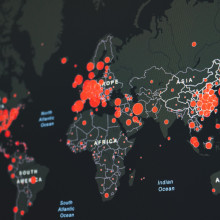
01:02 - Coronavirus globally: WHO plans for next wave
Coronavirus globally: WHO plans for next wave
Soumya Swaminathan, WHO
A pandemic isn’t a problem any country can solve on its own - after all, eliminating the coronavirus in your own home doesn’t do much good if it can easily return from your infected neighbours. So the World Health Organisation has been coordinating the international effort, despite criticism over its initial handling, and threats from President Trump to pull American funding. Soumya Swaminathan is the World Health Organisation’s Chief Scientist. She spoke to Phil Sansom about the global balancing act...
Soumya - We've been working particularly with those countries with weaker health systems, and our teams have gone into many different countries now to work with the national governments in developing strategies. So 80% of countries now have a national strategic response plan for COVID-19.
Phil - How do these strategies vary country by country?
Soumya - It depends a lot on the state of the health system and the resources that are available. And in fact after the Ebola outbreak, WHO actually went out and said very clearly that an unknown pathogen could really threaten the world, and the only way to deal with that is to really have good surveillance systems, good primary healthcare systems. And of course now we realise that in many countries this is not the case. And what we are seeing I think is very telling, because what we're seeing is a devastation that's happening in the high-income countries - in countries where we think health systems are very robust. And we see the intensive care units and the hospitals being overrun by patients, and healthcare workers just unable to cope.
Phil - Is that a case of where the pandemic actually is? Or is that a case of, there's more testing in the higher-income countries?
Soumya - The testing for this virus is a molecular test; it's what we call a PCR test. You need a PCR lab. Many countries in Africa do not have it. And that was a reason for the late picking up of cases, but I think that's not the only reason. The epidemic is maturing at different times in different parts of the world. And you see the wave from Southeast Asia, then in Europe, now North America, potentially Africa, the Middle East, South Asia.
Phil - In one of these lower-income countries, can you give me an example of what one of your strategies might involve?
Soumya - One is of course to get people to build up the capacity to do the testing, and so in the last two months we've sent out more than a million and a half diagnostic kits to many of these countries. We had training of lab technicians and labs in every country in Africa for example. Then it was building up the national response plan; making sure that hospitals have enough equipment like oxygen, personal protective equipment; training of healthcare workers; and then community information and education of the communities, because in many ways this is asking people to change their behaviour. You're being asked to stay at home, cut all your social activities and connections; and of course again in the low-income countries we have to deal with situations where people have to go to work on a living and to eat. We're still grappling with: what is the right approach, what's the right balance? On the one hand, you need physical distancing and avoiding people getting together in one place in order to cut transmission. On the other hand, there's the economic need and the human need to make sure that people are not starving and they're not suffering.
Phil - What about the scientific research into dealing with the coronavirus? What have you done so far?
Soumya - We developed a multi-country large randomized trial called the SOLIDARITY trial to look at potential drugs that could have activity against this virus, and currently we have over 80 countries that will be enrolling patients. The first drug is Remdesivir, an antiviral drug that was tested against Ebola was not found to be effective; but this is also an RNA virus, so we are testing it against this. Chloroquine and hydroxychloroquine, which of course are old drugs and are used, other than malaria, for other diseases. A drug called Lopinavir and Retonovir, it's a combination anti HIV drugs. And the fourth is a combination of Lopinavir/Retonovir with interferon beta one which is an immune stimulant. Within a couple of months, I hope that we will have results.
Phil - If any of these drugs that you're testing do end up really working, what's the plan then? Especially with regard to some of the poorer countries that we were talking about?
Soumya - That's a really good question and I think that's something that WHO always has right up front: equitable access, to people all over the world, regardless of whether they're able to pay or not. We have organizations like Global Alliance for Vaccines which distributes vaccines in 73 countries, mostly low-income countries. We also then have to think about middle-income countries, where most of the world's poor actually live today. And then of course the high-income countries also certainly need the vaccine. So it's a question of, what could be a formula or principles to decide this? For example, if we had the first few tens of millions of doses of a vaccine, who would we prioritise? Would it be healthcare workers around the world? Healthcare workers plus the elderly? We may have to face some of these questions.
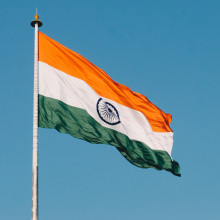
06:53 - India in lockdown: "a difficult time"
India in lockdown: "a difficult time"
Lalit Kant, Public Health Foundation of India
A large chunk of those who need the most healthcare aid live in the world’s second most populous country - India. And while India has had less than 10,000 confirmed cases so far, they’ve still gone into lockdown - like many African countries in similar positions - to preemptively stop the coronavirus wreaking havoc across the nation. Lalit Kant is an epidemiologist advising the Public Health Foundation of India, and he gave Phil Sansom an idea of the consequences...
Lalit - India is going through a difficult time. We are entering into a period where the government had instituted a strong lockdown. Trains were stopped, the bus stopped, the aeroplanes were stopped. The bordes, were all sealed. 17% of cases come from one single state, also from that state come around 41% of total deaths - Maharashtra. But there are states in India which have a slow growth rate.
Phil - Here in the UK the government's actions have been based, for better or worse, on these modelling studies. Has the Indian government been following something similar?
Lalit - Well there's been advice given to the government of India by different modeling groups and they paint a very stark picture. And at the peak there might be 100 million people infected; 10 million are expected to be, you know, bad. And then they did another scenario that said between 15 May and 30 May we'll get about 1 million cases, 30,000 deaths. All the mathematical models are as good as the input that you have to put into it. But at least we have some indication to go by.
Phil - Those are some staggeringly high potential numbers though.
Lalit - India has its own problems, you know. The population is big; density of population is high. We have a huge slum population - 20% of our population may be below the poverty line. We have a public health system which is not very effective. We have a poor surveillance system. People have lot of blood pressure, cardiovascular disease, diabetes; great challenges that we need to address.
Phil - Are there any plans for how to address those right now?
Lalit - The government is taking the battle to where the enemy is. Hand to hand combat. And India's fight could make or break the global war. We have a good capacity to test but the government of India has always been criticised for testing too a smaller number, so they want to make up by increasing that. And the government has also developed a cluster containment plan where the entire focus would be on those areas where there is community transmission happening. And the government has also put in place an economic package. Stadia are being converted, banquet halls are being converted, the ventilators are being procured. Many of these industries have started to make ventilators and the government of India is also importing large numbers of equipment. I think putting everything together we should be able to manage it.
Phil - And what about this 20% of people living in poverty? How are they handling this need to wash your hands, the need to stay a little bit apart, if you live without much to your name, and so close together?
Lalit - It's a big challenge. Bombay for example, they have a slum area called Dharavi, 10 to 12 people live in small tin hutments, so 10 by 10. If people have to spend money to buy water, 80 people share one toilet, then you know, observing all these things becomes difficult and therefore we need to put all our attention there so we are able to increase the testing and isolate those who are positive.

11:11 - Coronavirus airport screening "not effective"
Coronavirus airport screening "not effective"
Katie Gostic, University of Chicago
While air travel has spread this virus around the globe, there have been differing opinions amongst governments and scientists about the merits of closing down airline routes. Some countries have stopped flights altogether but many planes are still flying, albeit usually with screening measures at airports. But as Chris Smith has been hearing from Katie Gostic at the University of Chicago, this screening may not actually be effective...
Katie - The sort of traveler screening historically has not been particularly effective for other pathogens, but we were trying to get a better estimate for how it might play out for this coronavirus.
Chris - What sorts of screening are and were people doing?
Katie - The typical screening approach involves a symptom screen, which basically means that your temperature is taken and if you have obvious respiratory difficulties or a cough that would be noted by whoever's doing the screening. And then there's usually also a questionnaire that asks you things about your risk factors. So for example, have you been in an area where we know that there's a coronavirus outbreak.
Chris - And when you look into this, actually what was your approach?
Katie - The first thing we did was we asked, what's the probability that any single individual passing through screening would be caught? To do that you basically need to come up with a probability that an infected person is detected in the symptom screen and then another probability that they're detected in the questionnaire-based screening. We can come up with those probabilities based on what we know about the biology of the virus. We basically estimate that people are unlikely to realise they have been exposed to coronavirus, based on the fact that a lot of cases were showing up early who weren't able to report a clear source of exposure. And then in terms of the probability of having started to show symptoms, we can estimate that based on how long the incubation period of the virus is known to be.
Chris - Do you then take, what, real world travel data? And ask, “with these assumptions, how many would we find?”
Katie - We can test how well it's working by comparing it to real world data. Basically to do that, you know at what time different countries had implemented airport screening, and once someone passes through screening and later ends up in the hospital, then we know that screening has failed to detect that person.
Chris - Right. And on the basis of your model and your assumptions, how effective is this screening?
Katie - So we estimate that even in the best case scenario, that screening is probably missing 50% or more of infected travelers with coronavirus. The vast majority of people who would feel well enough to travel probably don't show symptoms at the time that they pass through screening. And we know that the incubation period for this pathogen is pretty long. And we know that there are some people who are completely asymptomatic. And so basically those people who either don't yet show symptoms or might never show clear symptoms are just undetectable.
Chris - Gosh, 50%. That's enormous.
Katie - Yes. We think that this is one of the big reasons that the virus was able to spread so easily.
Chris - We are where we are now: we've got a quarter of the world's population, in late March, currently experiencing some kind of lockdown. What can we take away from what you've found here, that obviously it may be a bit late for this situation, but so that we don't get SARS-Coronavirus mark three in the future?
Katie - I think that's a difficult question. One obvious extreme end of the potential solutions would just be to shut down air travel networks as soon as we detect the next emerging infectious disease. That obviously comes with serious economic implications, but on the other hand, what we've seen here is that it's really difficult to screen for emerging infectious diseases at airports and that air travel is a really important driver of global spread. And so usually the way that public health agencies respond to these scenarios is that as soon as the case is detected, public health professionals try to round up anyone that the first imported case might've been in contact with and infected, before those people can start new chains of transmission. People in my field often talk about new epidemics as being like fires, and these first imported cases like throwing sparks on the ground. We often can't prevent every spark from coming in, but we can do our best to prevent a big fire from starting.

16:46 - Coronavirus: "ACE2" blocks infection in lab
Coronavirus: "ACE2" blocks infection in lab
Josef Penninger, University of British Columbia
There’s a huge effort going in laboratories around the world to find a treatment for COVID-19 and a vaccine. And in Vancouver, a team of scientists may have found a way to stop the coronavirus infecting cells in the lungs. They’ve used a drug called “soluble ACE2” that acts as a decoy to the virus, so instead of attacking human cells, it attacks the drug instead. Chris Smith heard more from researcher Josef Penninger...
Josef - We tried to find out if a molecule we had engineered, which looks basically like the gates the virus needs to infect us... if blocking the gate could actually be used to block the virus. And this is exactly what happened.
Chris - Right, so there is a target on cells that the virus wants to infect, and it looks for that target and uses that as the doorway. You're saying if we make a fake doorway, we can fool the virus into spending all its time trying to go through a doorway that's broken, rather than one that really exists into the cell?
Josef - Correct. This is exactly what we tested in our paper. We infected cells with the virus and basically gave them this wrong doorway, and by giving the wrong doorway we could reduce the virus infection by a factor of 1,000-5,000 times.
Chris - What's the doorway?
Josef - The doorway is a molecule which we call angiotensin converting enzyme number 2. The normal function is actually to maintain our blood pressure, to protect our heart, to protect our kidney, to protect our lungs from inflammation processes, which actually are damaging our tissues. When the virus binds to this molecule ACE2, it actually takes it away from the surface of the cell. And this is the reason why we believe SARS and now COVID-19 became such lethal diseases: because it's actually hit the molecule which is protecting multiple tissues in our body. So we basically give a molecule and engineer the molecule, which looks like ACE2, but basically free floats around in the body, so it does not allow the virus to get into the cells.
Chris - And how far have you got with testing this? What have you done so far?
Josef - What we have shown so far is that in cells grown in a dish, this can indeed block the infection by a factor of 1,000-5,000 times.
Chris - Obviously you've intervened at what would be an early stage of the infection, but many people don't develop severe disease until they've had it for quite a while. It's almost like it falls into two phases; there's the initial fairly mild phase, and then the other effects and the deterioration kick in later. Would it be by then too late for this?
Josef - You're absolutely right. This is an important consideration. We’ve got now the commission to do a phase two clinical study in COVID-19 patients, and the patients we will treat are actually patients who have severe disease, so who are already at the later stage of the disease. The reason why we do this is because in these patients, the virus is actually spreading from the lung into other tissues, into the kidney, into the liver, into the heart, and of course we hope that our drug candidate can catch away the virus so it does not reach these other tissues.
Chris - The question is though, why is it that four fifths of people will bat this away with very, very, very trivial symptoms, and only about a fifth of people will develop more severe disease? Everyone's got this angiotensin system running in their body. So why is it that some people end up needing help from molecules like the one you've invented, and others don't?
Josef - Yeah, honestly I have no idea. I think this is one of the critical questions of why is it that somebody has a hyperactive immune system, which of course drives the disease, and I think this will be a very important question to answer. Why is it that older people are mostly affected with severe disease? We do know that for instance, younger people have less ACE2, older people have much more ACE2. We do know that smoking for instance induces ACE2 in the lung. Diabetes induces ACE2. So basically in these conditions there would be more receptors, more doorways available for the virus to infect us. This could partially explain this phenomenon why some people get it worse, but I think there must be other answers like an ageing immune system for instance.
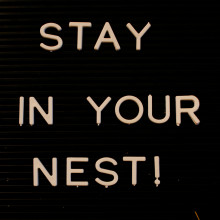
21:32 - UK lockdown: are Brits staying at home?
UK lockdown: are Brits staying at home?
Peter Cowley, Angel Investor
People in more than forty countries around the world are adapting their lives to a locked-down society. Here in the UK, researchers at Oxford have been using data from mobile phones to understand and predict the impact of the government’s social distancing measures on population movement. So are Brits truly staying at home? Phil Sansom heard from Naked Scientists tech correspondent Peter Cowley...
Peter - Well we'll explain in a minute how the technology works, but basically they've come up with some headline figures, some of which are quite astonishing. Apparently since the beginning of March, the population movement’s dropped by 98%. Now this 98% is based on a hundred metres from one's normal place of residence, which of course, for almost all of us, it's the home. That seems a large number. 55% of Britain stayed at home on Easter Monday. I'm surprised that it's as low as that actually, I would have thought it to be more.
Phil - That's only half. Yeah.
Peter - Exactly. I mean, I went for a run or a cycle or something that day, but not everybody did. As we've heard on the news, overall hospital footfall has fallen dramatically and as you've seen, the A&E departments are trying to attract us back in again, so we don't have a stroke or a heart attack and don't go into hospital. There was a load of data collected and analysed. There's a lot they can do with this, but this was the initial response.
Phil - 98%! That does seem... I know we're locked down, but that still seems high. How have they figured this out?
Peter - They figured this out using data from three sources. One of them is so-called Facebook Data for Good. I'm not quite sure what that is. But the other two I'm more clear on. There's a company called Cubiq, with a Q at the end, that collects data from apps. These are apps that one loads onto one's phone and agrees for the GPS location to be reported back. There's about 500,000 of those. And then something called C.K Fata, which is slightly more interesting cause it's collecting data from mobile phone masts. Not as accurate as the GPS, but it tells you which cell you're in.
Phil - So a lot of it is apps that you'll have clicked “yes, location services, that's fine,” not realising that in the terms and conditions that says can go to, you know, Oxford researchers.
Peter - You said that Phil, not me, but that's probably correct. Exactly.
Phil - When it comes to that third part, the phone mast data, how does that work?
Peter - As you move between areas, so in a car, on a train or whatever, you move between mobile phone masts. Each mobile phone mast knows location, so it can pass it on to the next one. It's within... obviously in some places like say the Lake District, it might be covering several kilometres. In the center of London, it might be covering just several tens of metres. But it gives you a reasonably accurate position, certainly in a built up area, of where the mobile phone is.
Phil - So how many people are they covering?
Peter - They don't... they're not willing to say. They say about 500,000 come from the apps. If you look at the ownership of the company, C.K Data, it's partially owned by one of the big mobile phone networks in the UK. So I suspect it's many millions of users they have data on.
Phil - So overall, this seems to be a lot of people. Have they figured out, say that the 55% of people who stayed at home on Easter Monday, how many of those who didn't went further afield than their government mandated run or exercise?
Peter - A very good question and I can't tell you the answer, I think you'd have to interview the people, the academics there. I suspect that data will be there, and I suspect that data would be something that if we were to have the sort of, I won't say police state, but I happen to know somebody in Italy and they're fining tens of thousands of citizens a day for nonessential travel. Whereas we're just fining hundreds of people a day, so that data could definitely be used in a state that was becoming stronger on enforcing nonessential travel.
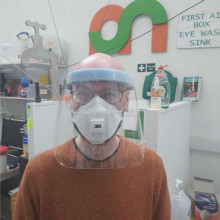
25:27 - Coronavirus volunteers make hospital visors
Coronavirus volunteers make hospital visors
Julia Citron, Makespace
Beyond the efforts of healthcare staff and other key workers, many other people around the world have been volunteering their time and resources in the fight against COVID-19. Here in Cambridge, crafters from the Makespace community workshop have been busy engineering thousands of plastic visors for the local Addenbrooke's hospital. Katie Haylor spoke to Makespace volunteer Julia Citron...
Julia - One of the engineers who's part of our community works with Addenbrooke's Hospital and we got in touch with them to find out what it was that they really needed, and that they didn't have yet. The first thing that came to the top of the list was plastic visors.
Katie - What's the actual production process?
Julia - It's like a mask, a face shield. It's got a simple foam band around your forehead and then some sort of rigid plastic that goes to just under your chin, and it's tied together by some elastic behind your head. It's very simple. The plastic parts are cut on the laser cutter, somebody cuts the foam strips on the bandsaw and then another person staples the elastic, and then there's a very careful quality assurance process to make sure there are no sticking out staples, or bits that aren't fastened properly.
Julia - And then a very careful packaging process, where we have to put on labels saying that the elastic has latex and things like that. We worked with Addenbrooke's to create a document that spells out in a lot of detail exactly how they want them made, and packaged, and labeled, so that they make sure they're safe and they're not going to do more harm than good by spreading infection. Our first batch of materials was tricky to get hold of, cause there's a national plastic shortage at the moment, but one of the volunteers who'd signed up to help works in a factory where they make food packaging, and it just so happened they had a big roll of plastic that they usually use to make transparent cake boxes, that was just the right specification that we needed for these visors. So we got a volunteer to drive over and load it into their car, all 96 kilos of it. And we've been making the plastic from that.
Katie - How many have you actually made so far?
Julia - Just yesterday we made our five thousandth visor. The first thousand masks we made, we gave to Addenbrooke's and then they realised that they actually needed many more than we could make. So they took the document that we'd written together, describing exactly what the visors needed to look like and how they needed to be made. And they've given it to a factory in Sydney who's now manufacturing 10,000 of these visors a week. So we had 4,000 visors to give away to community organisations, and have been overwhelmed with requests from all across Cambridgeshire and the Southeast of England.
Katie - It's a really stressful, anxiety-provoking time for a lot of people at the moment. What is it like to be involved in such a positive, proactive community?
Julia - It's really nice to not feel completely helpless, to feel like we can do something useful, and to feel connected to your local community and to the community of makers at a time like this. A big thank you to all of the volunteers who've been involved sourcing materials and spending their Easter weekend stapling visors in the Makespace lab and helping out in lots of big and little ways.

29:12 - Mailbox: Does extreme temperature kill coronavirus?
Mailbox: Does extreme temperature kill coronavirus?
Chris Smith, The Naked Scientists
Listener Ian asked: "Does extreme temperature incapacitate this virus? Does cooking work? What about a fridge, eg if I were to put it on a cold setting for a few days?" Chris Smith helped him out with an answer...
Chris - High temperatures will definitely deactivate coronavirus particles, and to be on the safe side that means more than about sixty degrees centigrade; whether that’s in the oven, in the dishwasher, or when you put fabrics into the washing machine. The fridge and extremely low temperatures are a quite different story. We routinely store viruses in very cold temperatures to preserve them for the long term for study and research and so on. And while it’s certainly true that freezing and thawing and refreezing viruses will deactivate some particles, many will remain intact and fully infectious. In the fridge, many of the conditions which lead to the natural deactivation of virus particles are not present: it’s cool, there’s no bright sunlight, and this means the particles remain intact and therefore fully infectious for longer. So high temperatures will deactivate viruses; low temperatures won’t necessarily deactivate viruses.
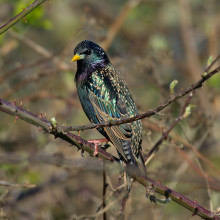
32:24 - Birdwatching: three common bird songs
Birdwatching: three common bird songs
Mark Eaton, RSPB
We’re starting our journey through the sky with the sights and sounds of the early morning. Even in the city you’ll still likely hear birdsong, and if you’re keen-eyed enough, you can spot them. Mark Eaton is from the RSPB, and has been a birdwatcher for four decades. He’s guided Chris Smith through telling apart the dawn chorus...
Mark - We're just going to listen to three of the commonest birds we can find in the UK, that most people will have around them in their gardens or in the local park, somewhere they can get to and enjoy birdsong. They're three quite familiar species many people will know already, so it’s slow step for getting into birds.
Chris - Number one on Mark's list is the blackbird. My favourite bird, overall, because I love the Latin name: Turdus! Let's hear what it sounds like.
[BLACKBIRD SONG]
Chris - Now, that really is very reminiscent of the dawn chorus. I reckon I've got quite a few of those who are waking me up each morning. What other ways might we recognise a blackbird though?
Mark - Well certainly they are that archetypal bird of the dawn chorus, and if you wake up early in the morning - if unfortunately something wakes you up - that's often the first thing, the first bird that starts singing in the morning, so you can hear them on their own before the others, the sparrows and the pigeons join in. And it's a beautiful song. They like to feed on lawns, so if you've got any grass or park or you've got a lawn in your garden, you'll often see blackbirds bouncing around. They hop both feet together. And of course the clue's in the name; not the Latin name, not the slightly cheeky Turdus bit, but the blackbird. They are jet black, or the males at least are jet black, with that the yellow beak. The females are a bit browner, a bit speckled-y underneath. But you see those males with the sort of orangey-yellow beak and a little orange ring around the eye, the long tail; they're pretty unmistakable and they're very common. So most people will hear them and see them around where they live.
Chris - And do they eat worms? When you said they're feeding on the grass and things, are they going for worms and grubs and things?
Mark - They are, yes, yes. They are the sort of typical bird, cartoon bird digging for worms. Not many birds actually dig for worms, but blackbirds are one that really do specialise on finding worms in the lawns and in the undergrowth.
Chris - Let's sort of change it up a little bit, because the next bird on our list is the wren. So can we just hear what a wren sounds like?
[WREN SONG]
Chris - You see now I'm hearing these sounds, I'm recognising them and I realise that I've heard loads of these things without ever realising what they are. Tell us about wrens.
Mark - Wrens are actually our commonest bird. We have something like 11 million pairs of wrens in the UK, so 22 million of them. They're tiny! I mean that's why a lot of people won't realise. They might recognise that song; they might not have noticed wrens despite them being so common because they skulk around, they lurk in bushes, they're brown and streaky, so they're not very obvious, and they're absolutely tiny. They're about 10 centimetres long but they're incredibly loud; they have this voice you can hear from the length of a playing field away, belting it out. If you see them singing, their whole body vibrates, shakes while they're singing, such is the power they're putting into it while being nearly our smallest bird.
Chris - It's amazing. So size doesn't really come into it when you're a bird: size and volume don't go hand in hand, or I suppose hand in feather. But onto a different bird now and that's the starling now. These always used to be regarded as a little bit of a sort of a scruffy looking bird. Let's just hear their song for those who might not be so familiar.
[STARLING SONG]
Chris - See, I don't think that's half as tuneful as the prior two that we've listened to, but what can you tell us about starlings Mark?
Mark - I certainly stand up for starlings. I think they're fascinating birds. I mean one, you say scruffy, but if you see a starling this time of year, they're black but they have a beautiful oily sheen; a green and a purple gloss to their feathers, which are dusted with spots all over on the tips of the feathers. They're beautiful birds. And they make the strangest noises when they really get singing. It's like a robot trying to imitate a bird, I think; all sorts of strange trills and electronic sounding noises. And they're incredible mimics, they can really copy other birds they hear and other sounds they hear. Where I used to live I had a neighbour with a very annoying car alarm. Every day his car alarm would go off accidentally, it had some sort of fault. And the starlings learned the car alarm, so the starlings would copy the car alarm. So they're remarkable birds really, you might think they don't look like that much, but they are really clever. Fascinating birds. Worryingly actually not as common as they used to be. For every five starlings we had when I was young learning to birdwatch, there's only one left now, they've really declined. So not all well, but they are great birds.

37:22 - Cloudspotting: make a cloud in a jar!
Cloudspotting: make a cloud in a jar!
Mel Strong, Bradbury Science Museum
As the sky brightens throughout the morning, you’ll probably get a good view of the clouds. These enormous masses of air and water vapour form for quite specific reasons, and they aren’t all built the same. You can even use clouds to do some basic weather forecasting. Mel Strong is a weather expert from the Bradbury Science Museum in Los Alamos, New Mexico, and he ran Phil Sansom through the basics. Get ready, because it’s kitchen science time...
Mel - So today we're going to try to create a cloud in a jar. I want you to find a clear jar or a glass, and preferably something that has a lid. The lid doesn't have to be tight fitting - a piece of paper could serve as a lid for this. You're going to want to fill this jar a quarter to halfway full of warm water. Go ahead and put whatever lid you have on it and just set it aside. You're also going to need to get a little sandwich baggie full of ice cubes, and you'll need a match.
Phil - Okay, so I've got my jar and it's got the warm water in, and I've got my sandwich bag and I'm putting some ice cubes in it, and I've got my match. What do I do?
Mel - Okay, so the lid has been on your jar and as it's been sitting there, there's been water evaporating. Do you see anything on the sides of the jar right now?
Phil - Yeah, there's a bit of condensation.
Mel - What's happening is we have a lot of water vapour that's inside that jar. And the sides of the jar are relatively cool, and there's water that's condensating onto the sides of the jar. But that's not a cloud. What we're forming here is dew. To get a cloud, we don't want to cool the surface, we want to cool the air. So here's what we're going to do: I'm gonna explain it first, and I want you to do it kind of all in one motion.
Phil - Okay.
Mel - We're going to take the lid off the jar. We're going to light a match. We're going to blow out the match and immediately throw it into the jar, and then we're going to replace the lid with the bag of ice.
Phil - This is with the warm water in the jar?
Mel - Yes, right.
Phil - Here it goes. All right, I've done it. The ice is over it.
Mel - See if you see anything happening underneath the bag of ice.
Phil - I do! The air has become cloudy!
Mel - Yeah, so we are forming a cloud. Now, if you just peel the bag of ice back a little bit, the cloud might come out.
Phil - It's not coming out as a big puffy cloud, but it's coming out as cloudy vapour.
Mel - So we have cooled the air with ice. In nature, generally what happens is air is cool because it is lifted upwards into the atmosphere. When water condensates, it needs a surface to condensate onto. In nature, those surfaces are little tiny microscopic pieces of dust and salt: condensation nuclei. We added condensation nuclei with our match that added some smoke. When we put the ice over the top of the jar, we then cooled the air inside the jar such that condensation would occur on those little tiny smoke particles that we added.
Phil - Oh, so just like the water was condensing on the cool sides of the glass before, now it was condensing in the cool air, but on the little bits of smoke that came from the match.
Mel - That's right.
Phil - And that's really how clouds form?
Mel - That's really how clouds form.
Phil - Okay. If that's how clouds are made, how come you get different kinds of clouds?
Mel - Right. Almost all clouds are formed by air rising, and there's really two ways that air can rise. There's a whole class of clouds that we call cumuliform clouds, and these are the puffy, sort of cotton-looking clouds. When you see one of these, you know that air is rising because you have little pockets of air that are warmer than the air around it. The other type of clouds are more like blankets. We call these stratiform clouds, and in this case what's happening is the entire air above our heads, the entire sky you see is being uplifted slowly. They're pretty boring to look at. It makes a grey sky.
Phil - Okay, I've got all this new cloud knowledge. Is there anything I can do with this? Can I start to predict weather patterns?
Mel - There is actually a somewhat predictable series of clouds that you can get that we often refer to as a winter storm. You're going to start out with these high streaky ice clouds, so the sky's going to look streaky. And then you're going to notice that there's a ring around the sun, and maybe another half day later the sign is a fuzzy ball, perhaps a half day after that, the sun is not visible. Then we have rain and the rain will last maybe 24 hours or so. During this segment, what's happening is the warm pool of air is passing over our heads. This is called the warm front. Perhaps the next day you'll notice that the temperatures plummet and the sky seems to sort of break up, and the rain seems to have stopped. But what you'll notice is the types of clouds have changed to these little individual puffy clouds. And usually in a well-developed storm, these will turn into tall towering puffy clouds that we call cumulonimbus. And you'll see pockets of rain; generally we call this portion of the storm ‘scattered showers’. And this will happen for perhaps another couple of days. And then finally you'll be in this pool of relatively cold, dry air. So back to your question about weather prediction with clouds: if you see those initial steps, the ring around the sun, the fuzzy sun, you can pretty much bet that it's probably going to be raining in about 24 hours or so.
Phil - Okay. I can predict the weather!
Mel - Yes, you can. And you can imagine that if you were a farmer back several hundred years ago, this is how you would predict the weather.
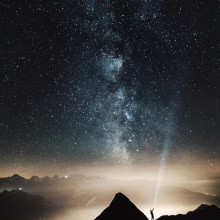
44:04 - Stargazing: a beginner's guide
Stargazing: a beginner's guide
Robert Massey, Royal Astronomical Society
This week we’re gazing up at vault of the heavens and revealing its mysteries. We’ve gone through the sky during the day, and now it’s time for the sky at night. Robert Massey from the Royal Astronomical Society taught Chris Smith the basics of stargazing...
Robert - Actually going to the Australian outback and looking up at the stars is the stuff of dreams in many, many ways for many people looking at it. But I think the best thing to do is to start to learn the constellations, the names of some of the stars above our head, and be able to spot the brightest planets in the sky. And also if you have access to something like a small pair of binoculars, that's a really nice addition too. It's important to realise you don't need to spend a great deal of money on expensive kit. I mean obviously that's very, very easy to do, but I think there's simply no point in doing that. The best thing to do is actually get a feel for the sky to begin with.
Chris - I'm glad you brought that up because that was sort of foremost in my mind. How do I know what I'm actually looking at? Because when I look at maps of the sky, and then I look up at the sky, it's quite hard to make that mental translation between what I see in a book and then what these bright pinpoints of light are. How do you do that?
Robert - You're quite right because you look at a map in a book, and it may be that that's a map showing you many more stars than you can see. If you're exceptionally lucky, you might be in a place where you see more stars than the book shows and that could confuse the shapes as well, but the best thing to do is to start to recognise the patterns and now there are some really nice signposts. For example, in the spring sky as we are now, pretty much after sunset you see the Plough, or the Big Dipper in North America, swinging overhead: those seven stars with that kind of saucepan shape. You can use the curve of the handle of the saucepan, track it down, and you come to a really bright star called Arcturus. And these kind of things are the way that you find your way around the sky.
Chris - It's interesting that you mentioned a star there, because of course when we look heavenward, we're going to see stars, we're going to see planets, and then we might even see small satellites that we've made and put up in space. So how do we tell them all apart?
Robert - That's a really, really good question. Something like Arcturus is a bright star and sometimes people think, “oh, maybe that's a plane or something.” And the answer is generally that stars tend to twinkle. And the reason they do that is that they're very far away, so they're effectively point sources of light; the light gets to us, it travels pretty much unfettered all the way through the cosmos, arrives at the Earth's atmosphere, and then the shifting air currents move that light around and we see a twinkling effect. Now with a planet, although planets are generally much smaller than stars, they're much, much closer. The ones we can see, they tend to look quite bright as well, which is another giveaway, but they have a steady light too. If you see something like Venus in the evening sky, as you can right now actually, you'll see it's not only bright but it's steady too. That's a great big giveaway. And something like a satellite, which kind of varies in brightness and so on... but actually again, they don't tend to twinkle or they move very, very obviously as well. It only takes a couple of minutes typically for a satellite to go from one side of the sky to the other.
Chris - Venus is incredibly bright, isn't it? Even I know where Venus is, and it stands out for being so bright. Mars: very, very red. Is that some other reason, that they look bright because they’re close to the Sun and red because they're made of red stuff, or is that a myth?
Robert - No, I mean the colour of Mars for example... if you want to see Mars actually, it's visible in the dawn sky just before the sunrise at the moment. And in the case of Mars, it is genuinely red; as if you ever look at the pictures from the rovers that have driven around its surface, that's really, really obvious. It's covered with this rusty stuff. Something like Venus generally has a whitish colour, because it's a thick carbon dioxide atmosphere and it reflects a lot of light, so it's genuinely bright. But planets, unlike stars, are shining due to reflected sunlight; and something like Venus is close to the Earth, it's closer to the Earth than the Sun is at the moment, and because it's close and it's about the size of the Earth, then we're seeing it well because it reflects a lot of light. And that light doesn't have that far to travel compared with a star, so it appears really, really bright in the sky. In fact, it's actually so bright that if you're in the right set of circumstances - and you can try this, but I would only suggest that you make sure the sun is hidden behind a building - you can actually see Venus during the day. I've done that quite a few times if the sky's very, very clear.
Chris - And just to finish, Robert, can we just bring up one thing which really does deserve recognition; because this week, a very important birthday is going to be celebrated: 30 years since the Hubble Space Telescope was launched. And it's really been something that's been present throughout my growing up and has revolutionised arguably our understanding of the heavens and our view of the skies. I just wondered if you had any thoughts on that too.
Robert - Absolutely extraordinary success. The remarkable thing is when it was launched back in 1990, it didn't work that well because the mirror was slightly the wrong shape, so they had to fly a correction mission up a couple of years later; and then all of that was forgotten because ever since that time, it's been a phenomenal success. It's sent back images of planets in our own solar system, of distant galaxies. Actually, it's helped find planets around other stars and forming solar systems around other stars, and it also helped us understand the age of the universe. So it's been an extraordinary success.
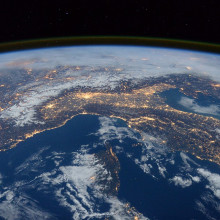
49:20 - Spacewalking: the view from the Space Station
Spacewalking: the view from the Space Station
Steve Swanson, NASA Astronaut
Steve Swanson is a former NASA astronaut who during his career helped build the International Space Station, and is a former ISS commander. Phil Sansom asked him about his tips for dealing with isolation, as well as what the view is like from so high up...
Steve - My first spacewalk, I went out the hatch and I worked my way out to my work site, which happens to be on the very end of the station, the last hand rail on that side of the station. I set myself up getting ready to work, started working, all this; and then the sun comes out and I get to see the earth way down below me and the space station off to the side. I gripped my hand rail so tight I didn't move for a minute. Because it was like this idea that you're way above Earth with nothing below you, and you should be falling down, and this is not a safe place to be. It's not on a conscious level, like "I can control this, I can figure it out". There was some sort of innate kind of fear thing and you don't really have much control over it for a minute until you calm yourself back down.
Phil - That view that you get... how does the view you get of the night sky from the ground compare to what you get when you're up there in space?
Steve - The biggest difference is there is not an atmosphere to look through. So there's no twinkling of the stars, they're all just pinpoints of light. It was not so easy to stargaze on the space station. We don't really have a window that goes up. If you wanted to look at a star, which we'd get to a couple of times because we'd move the altitude of the station a little bit, we had to make this area really, really dark. And it's like trying to see the stars from inside your house: if there's any lights on at all, it's gonna ruin it, you can't really see anything. So we would... I made a blanket with Velcro on the edges that I could put around this whole area and really make it dark, and then we could watch the stars.
Phil - I don't know about you - are you in lockdown like so many of us across the world?
Steve - Yes. We're at a stay at home policy here in Idaho.
Phil - How does that compare to being up there in space with maybe just a couple of other people? Is there a similar isolation or is it very different?
Steve - Yeah, I guess similar in a way, it's quite a bit easier right now, at least where I am. Because I can go out and go for walks or runs or go to the grocery store. I can still do all those things. I just have to be careful about what I do when I do that. On the space station, I mean, you just can't go outside, right? And so you're stuck inside for almost six months.
Phil - Have you got any tips then for how to keep healthy and emotionally OK? And generally well?
Steve - Yeah, so I mean it's... everybody's gonna be different, so I'll say what works for me and maybe people can take this and adapt it for what works for them. First thing was: stay busy. And that wasn't really a choice on the space station, it was a very busy schedule, it was like a 12 hour work day. So I didn't really think about, "oh, I'm isolated, I can't go back home and can't do these things". I was enjoying my time up there and I was busy. Next thing is: stay in communication with your friends and family. And the last thing I like to say is: definitely have some fun too, because now if you're stuck in your house, you're not going to be doing the same things you would normally do. And we did that on the space station, we came up with new games to play in this floating environment, and it helped relieve all our stress and tension.
Phil - Like what sort of games?
Steve - Oh man. Well we had Nerf dart guns, so we would come up with a game of... we could do duels. We had a full-on Nerf dart gun war the first time we brought out the Nerf dart guns, and there was only nine bullets out of all this and it took us an hour and a half to find them. So we decided not to do that again, so we came up with, everybody gets one bullet, we'll just do duels and stuff like that. Competitions to see who could do the most flips... basically our fun day was Sunday. We played all sorts of games.

53:09 - QotW: How do c-section babies get their gut microbes?
QotW: How do c-section babies get their gut microbes?
Pavel sent in this question - and Adam Murphy delivered an answer...
Adam - The microbiome is the collection of bacteria that exist in, and on you. It’s an ecosystem in its own right, and issues with a person’s microbiome have been linked to a litany of diseases. So it’s important, if we can, to put the best foot forward. So what happens to the microbiome during a caesarean section? We reached out to Peter Brocklehurst from the University of Birmingham.
Peter - It depends on whether the waters around the baby are intact or broken at the time of the caesarean section. If the caesarean section is done after the waters around the baby have broken, whether this is in labour or before labour starts, then bacteria from the mother's vagina can reach the baby and be present in the baby's gut at the time of the caesarean section. We believe that the longer the waters are broken, the more likely the varieties of bacteria in these babies will resemble those of a baby born vaginally.
Adam - When the mother’s water breaks, the fluid filled sac in the womb, called amniotic sac, ruptures, and usually happens at the start of labour, but not always with a ceasarean section
Peter - Babies born by caesarean section with the waters intact, which is more than half of all births by caesarean section, pick up bacteria from the environment. This can include the mother's skin, the midwives hands, any instruments used after the birth – such as oxygen masks if the baby needs help breathing – and other hospital surfaces that the baby, or anyone handling the baby, may come into contact with. Our research showed that babies born by caesarean section with intact waters were much more likely to have bacteria in their guts which are found in hospitals, and some of these potentially harmful bacteria were resistant to antibiotics.
Adam - There are many reasons a mother may choose to have a caesarean section, both personal and medical. These reasons are totally valid but given our continually growing understanding of the importance of the microbiome, it’s worth understanding what happens at all stages of life.
Peter - We don’t yet know what this means for babies in the long term. Once babies start feeding and being exposed to all sorts of other bacteria as they get older, the types of bacteria babies have in their guts changes and becomes more similar, but even after 6 months we still found more potentially harmful antibiotic-resistant bacteria in the guts of babies born by caesarean section.
Adam - Thank you Peter, for doing the labour in bringing us that answer, next week, we look into this question, which has been getting on Matt’s nerves.
Matt - Do all humans have the same number of nerve endings on their skin? And if so do those of us who are bigger, either taller or fatter, have the same sensitivity of a given area of skin reduced?










Comments
Add a comment